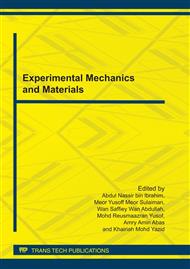p.210
p.216
p.224
p.230
p.237
p.244
p.249
p.255
p.261
Effect of Grain Size on Vickers Microhardness and Fracture Toughness in Calcium Phosphate Bioceramics
Abstract:
Grain size dependences of Vickers microhardness and indentation fracture toughness in fully dense hydroxyapatite bioceramics without additives were studied. The nanostructure and highly pure Hydroxyapatite powders produced by wet chemical precipitation method were used as starting material. After uniaxial and cold isostatic pressing, the green HA samples sintered at temperatures ranging from 1000 °C to 1300 °C with one minute holding time. Dense compacts with grain sizes in the nanometer to micrometer range were processed. The average grain size of HA compact sintered at 1000 °C was around 500 nm. Grain size increased to 3 µm when the compacts were sintered at a higher temperature. The average microhardness value of sintered HA decreased with an increased in grain size. Indentation fracture toughness for HA compacts of 700 nm grain size was 1.41±0.4 MPa.m1/2 which is similar to fracture toughness of human cortical bone.
Info:
Periodical:
Pages:
237-243
Citation:
Online since:
July 2011
Authors:
Keywords:
Price:
Сopyright:
© 2011 Trans Tech Publications Ltd. All Rights Reserved
Share:
Citation:


